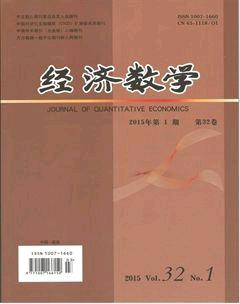基于随机双曲折现的投资消费及效用无差别定价
杨招军+罗鹏飞


摘要 在随机双曲折现条件下,显式地给出了具有指数函数(CARA)效用的最优跨期消费与投资组合;在非完备市场下,显式给出了基于CARA效用的收益流的效用无差别价格.结果表明:最优投资比例以及收益流的价值不受随机双曲折现因子的影响;在低折扣阶段,本文的最优消费水平高于Merton模型下的对应值,低折扣时期越短或高低折扣值相差越大,消费差距越明显.
关键词 随机双曲折现;投资消费;效用无差别定价
中图分类号 F224.0 文献标识码 A
AbstractWe explicitly derive the optimal intertemporal consumption and investment with stochastic hyperbolic discounting for a constant absolute risk aversion (CARA) investor. After that, we explicitly present the utilitybased indifference price of cashflows received by the investor. We find that the optimal investment and indifference price do not depend on the discount factor but during the low discounting period, the optimal consumption is more than that under Merton model. The shorter the low discounting period or the bigger the difference between the high and low discount factor, the more obvious the distinction between the two optimal consumptions.
Key wordsstochastic hyperbolic discounting; investment and consumption; utilitybased indifference pricing
1引言
很多经济决策问题都是跨期决策,需要对当前与未来报酬和消费的权衡,其中用来衡量现在与将来权重的折现率具有决定作用.例如,投资者在追求整体目标最优时,往往会在较小且较早的报酬与较大且较远的报酬中做出权衡,选择的结果决定于时间折扣率:只有当折扣系数随时间衰减足够快时,投资者才会偏好较小且较早的报酬.
目前具有常数折现率的指数折现函数被广泛用来分析经济问题.这种指数折现函数确定的时间偏好是连续一致的,不会产生任何急剧变化.然而,心理行为科学家和经济学家有大量实验证据表明:人的偏好并不是连续不变的,参见Thaler and Shefrin(1981)[1],Ainslie & Haslam(1992)[2],Kirby and Herrnstein(1995)[3],Myerson and Green(1995)[4],Dellavigna and Malmendier(2006)[5].为此,经济学家引入了随机双曲折现模型,即在未来某个随机时刻以后,时间折扣因子急剧减少.参见 Barro(1999)[6], Dellavigna and Malmendier(2004)[7], Grenadier and Wang(2007)[8], PalaciosHuerta and PerezKakabadse (2013)[9],Zou et al(2014)[10].
PalaciosHuerta and PerezKakabadse (2013)[9]基于随机双曲折现模型,给出了在无限生命期内,具有幂效用(CRRA)投资者的消费投资问题,给出了最优消费和投资的解析解.Zou et al.(2014)[10]将Haris and Laibson(2013)[11]的随机双曲折现模型结合Merton(1969,1971)[12,13],考虑了在有限生命期内的最优消费和投资问题,对对数效用函数给出了解析解,幂效用给出了数值解,得出与Merton模型相比较,随机双曲折现提高了消费水平,同时,投资在风险资产的比例不受其影响.
上式表明:基于随机双曲线折现模型,具有随机收益流的投资者在无风险资产的比例不受随机双曲参数的影响;相比Merton模型,本模型的最优消费水平更高,当β越小或λ越大,其差别越明显.即在低折扣阶段,本文的最优消费水平高于Merton模型下的对应值,低折扣时期越短或高低折扣值相差越大,消费差距越明显.这与上文的解释相同.
4结论
本文研究了随机双曲折现条件下,具有指数效用(CARA)的投资者的跨期消费储蓄与投资组合,以及在非完备市场下基于CARA效用的收益流的效用无差别定价.本文得到了企业家的最优消费、最优投资以及收益流效用无差别价格的解析解.结果表明最优投资比例以及收益流的效用无差别价格不受随机双曲折现因子的影响;本文的最优消费水平高于Merton模型下的对应值,投资者越偏好当前消费,其差距越明显.考虑到资产定价与投资消费具有密切的关系、以及当投资者收益流面临较大本性风险时效用无差别定价具有明显的合理性,本文结论对于进一步发展随机双曲折现条件下的资产定价理论具有一定的参考价值.
参考文献
[1]R H THALER, H M SHEFRIN. An economic theory of selfcontrol [J]. Political Economy, 1981, 89(2): 392-406.
[2]G AINSLE, N HASLAM. Hyperbolic discounting[C]//Loewenstein, George, Elster, Jon(Eds.), Choice Over Time. Russell Sage, New York, 1992.
[3]K N KIRBY, R J HERRNSTEIN. Preference reversals due to myopic discounting of delayed reward [J]. Psychological Science. 1995, 6(2): 83-89.
[4]J MYERSON, L GREEN. Discounting of delayed rewards: models of individual choice [J]. Journal of the experimental analysis of behavior, 1995, 64(3): 263-276.
[5]S DELLAVIGNA, U MALMENDIER. Paying not to go the gym [J].The American Economic Review, 2006, 96(3): 694-719.
[6]R J BARRO, 1999. Ramsey meets Laibson in the neoclassical growth model [J]. Quarterly Journal of Economics, 1999, 114(4): 1125-1152.
[7]S DELLAVIGNA, U MALMENDIER. Contract design and selfcontrol: Theory and evidence [J]. The Quarterly Journal of Economics, 2004, 119(2): 353-402.
[8]S R GRENADIER, N WANG. Investment under uncertainty and timeinconsistent preferences [J]. Journal of Financial Economics, 2007, 84(1): 2-39.
[9]I PALACIOSHUERTA, A PEREZ KAKABADSE. Consumption and portfolio rules with stochastic hyperbolic discounting[R].Spain:University of the Basque Country, 2013.
[10]Z R ZHOU, S CHEN, L WEDGE. Finite horizon consumption and portfolio decisions with stochastic hyperbolic discounting [J]. Journal of Mathematical Economics, 2014(52):70-18.
[11]C HARRIS, D LAIBSON. Instantaneous gratification [J]. The Quarterly Journal of Economics. 2013, 128(1): 205-248.
[12]R C MERTON. Lifetime portfolio selection under uncertainty: the continuoustime case [J]. The review of Economics and Statistics, 1969, 51(3): 247-257.
[13]R C MERTON. Optimum consumption and portfolio rules in a continuoustime model [J]. Journal of Economic Theory, 1971, 3(4): 374-413.
[14]X L WANG, Z J YANG. Pricing Contingent Convertible Bond with Idiosyncratic Risk[R].Changsha: School of Finance and Statistics, Hunan University, 2012.
[15]王晓林,杨招军. 非系统风险与公司最优资本结构[J]. 经济数学, 2014, 31(1):21-28.

